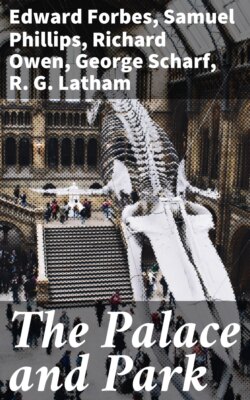Читать книгу The Palace and Park - Edward Winslow Forbes - Страница 8
На сайте Литреса книга снята с продажи.
Оглавление[10] “The Red,” probably so called either from the colour of the soil, or from the deep red brick of which it is built.
The part here reproduced is the far-famed Court of Lions, the Tribunal of Justice, and the Hall of the Abencerrages and the Divan. The outside of these courts is covered with diaper work, consisting of inscriptions in Arabic character, of conventional representation of flowers and of flowing decoration, over which the eye wanders, delighted with the harmony of the colouring and the variety of the ornament. Entering through the central archway, we see before us the fountain, supported by the lions that give name to the court; and, through the archway opposite, the splendid fringe of the stalactite roof of the Hall of the Abencerrages, composed in the original of five thousand separate pieces, which key into and support each other. The Court of Lions here is 75 feet long, just two-thirds the length of the original; the columns are the same height and size as the columns of which they are restorations, and the arches that spring from them are also of the actual size of the original arches. Over the columns is inscribed in Cufic characters, “And there is no Conqueror but God.” Round the basin of the fountain is an Arabic poem, from which we take two specimens:—
“Oh thou who beholdest these Lions crouching—fear not!
Life is wanting to enable them to show their fury!”
Less, we must think, a needless caution to the intruder, than the poet’s allowed flattery to his brother artist. In the verse of Greece and modern Italy, we find the same heightened expression of admiration for the almost animating art of sculpture. The following passage is oriental in every letter:—
“Seest thou not how the water flows on the surface,
notwithstanding the current strives to oppose its progress.
Like a lover whose eyelids are pregnant with tears, and
who suppresses them for fear of a tale-bearer.”
Through this brilliant court, the visitor will proceed or linger as his spirit directs. There are no statues to examine, for the religion of the Moors forbade the representation of living objects; in truth, the exquisitely wrought tracery on every side, upon which the Moorish mind was thus forced to concentrate all its artistic power and skill, is in itself sufficient exclusively to arrest and to enchain the attention. A curious infringement, however, of the Mahommedan law just now mentioned, which proscribes the representation of natural objects, is observable in the lions supporting the fountain, and in three paintings, which occupy a portion of the original ceilings in the Tribunal of Justice and the two alcoves adjoining. It is also to be remarked that, although the followers of Mahommed scrupulously avoid stepping upon a piece of paper, lest the name of God should be written thereon, yet that name is found repeatedly upon the floor of the same tribunal. However, during the State visit of the Princes of Oude to the Crystal Palace in 1858, while they were inspecting this Court it was noticed that they, and many of their attendants, avoided as much as possible stepping upon the inscribed pavement. From these circumstances it would seem that the Mahommedans of the West were more lax in their observances than their brethren of the East, having in all probability imbibed some of the ideas and feelings of the Spanish Christians with whom they came in contact.
Passing through the archway opposite to that at which we entered, we find ourselves in a vestibule which in the Alhambra itself leads from the Court of Lions to the Tribunal of Justice. This is, however, only a portion of the original passage. The arches opening from the central to the right and left divisions of the vestibule are of the size of the originals, the patterns on the Avails and ceilings being taken from other portions of the Alhambra. It should also be remembered that the different apartments here brought together do not stand in the same relation to each other as in the Moorish Palace, the object of the architect in the Crystal Palace being to give the best examples of this style of architecture in the smallest possible space.
The visitor may now proceed through the left-hand arch into the division next the Roman Court. On the right of this division he will find a small room devoted to models, and specimens of the original casts of ornaments of the Alhambra, brought by Mr. Owen Jones from Spain, from which this Court has been constructed. Returning to the central division, he sees on his left the Hall of the Abencerrages, with its beautiful stalactite roof, already spoken of. All the Courts on this side of the building, up to this point, were erected under the superintendence of Mr. Owen Jones. Proceeding onward, we quit the Alhambra, and emerge into the north transept.
The visitor passing into the Tropical division now crosses the Transept, immediately in front of the colossal sitting figures, which he will be able to examine with more effect when he commences a tour through the nave, which we propose that he shall shortly make. Passing these figures then for a moment, he directs his attention to
Pillar from the arcade of the Court.
